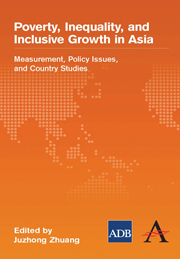Book contents
- Frontmatter
- Contents
- Foreword
- Preface and Acknowledgments
- Contributors
- Abbreviations, Acronyms, and Symbols
- Tables, Figures, and Boxes
- 1 Poverty, Inequality, and Inclusive Growth in Asia
- Part A Measuring Inequality and Poverty
- 2 Inequality and Poverty in Asia
- 3 Non-Income Poverty and Inequality in Asia
- 4 Gender Equality and Inclusive Growth in Asia
- Part B Selected Policy Issues for Inclusive Growth
- Part C Country Studies
- Index
4 - Gender Equality and Inclusive Growth in Asia
from Part A - Measuring Inequality and Poverty
Published online by Cambridge University Press: 05 March 2012
- Frontmatter
- Contents
- Foreword
- Preface and Acknowledgments
- Contributors
- Abbreviations, Acronyms, and Symbols
- Tables, Figures, and Boxes
- 1 Poverty, Inequality, and Inclusive Growth in Asia
- Part A Measuring Inequality and Poverty
- 2 Inequality and Poverty in Asia
- 3 Non-Income Poverty and Inequality in Asia
- 4 Gender Equality and Inclusive Growth in Asia
- Part B Selected Policy Issues for Inclusive Growth
- Part C Country Studies
- Index
Summary
Introduction
The importance of pursuing gender equality has long been recognized around the world, including Asia and the Pacific. Virtually all countries in the region are parties to the Convention on the Elimination of All Forms of Discrimination against Women, and gender equality is explicitly guaranteed in many constitutions and statutes (ADB et al. 2006). Indeed the region has made impressive progress in reducing gender inequality over the last few decades. Nevertheless, women remain disadvantaged in access to economic opportunity and resources, basic human rights, and political voice (World Bank 2007). Because gender discrimination directly affects the well-being of women, gender equality is a legitimate policy goal in its own right. At the same time, development organizations increasingly acknowledge the role of gender equality and women's empowerment as a powerful means to foster development and poverty reduction (e.g., ADB 2007 and 2008, World Bank 2008).
Inequality can result from differences in either effort, which is under the control of an individual, or circumstance—such as gender, religious background, geographical location, and parental education—which is not (Roemer 2006). Gender inequality is a prominent example of the latter. As described elsewhere in this book, inclusive growth is growth that not only generates economic opportunity, but also ensures equal access to opportunity to all segments of society (Ali and Zhuang 2007). Hence, inclusive growth can only be achieved if, among other things, gender disparity is properly addressed.
- Type
- Chapter
- Information
- Poverty, Inequality, and Inclusive Growth in AsiaMeasurement, Policy Issues, and Country Studies, pp. 115 - 158Publisher: Anthem PressPrint publication year: 2010
- 1
- Cited by



